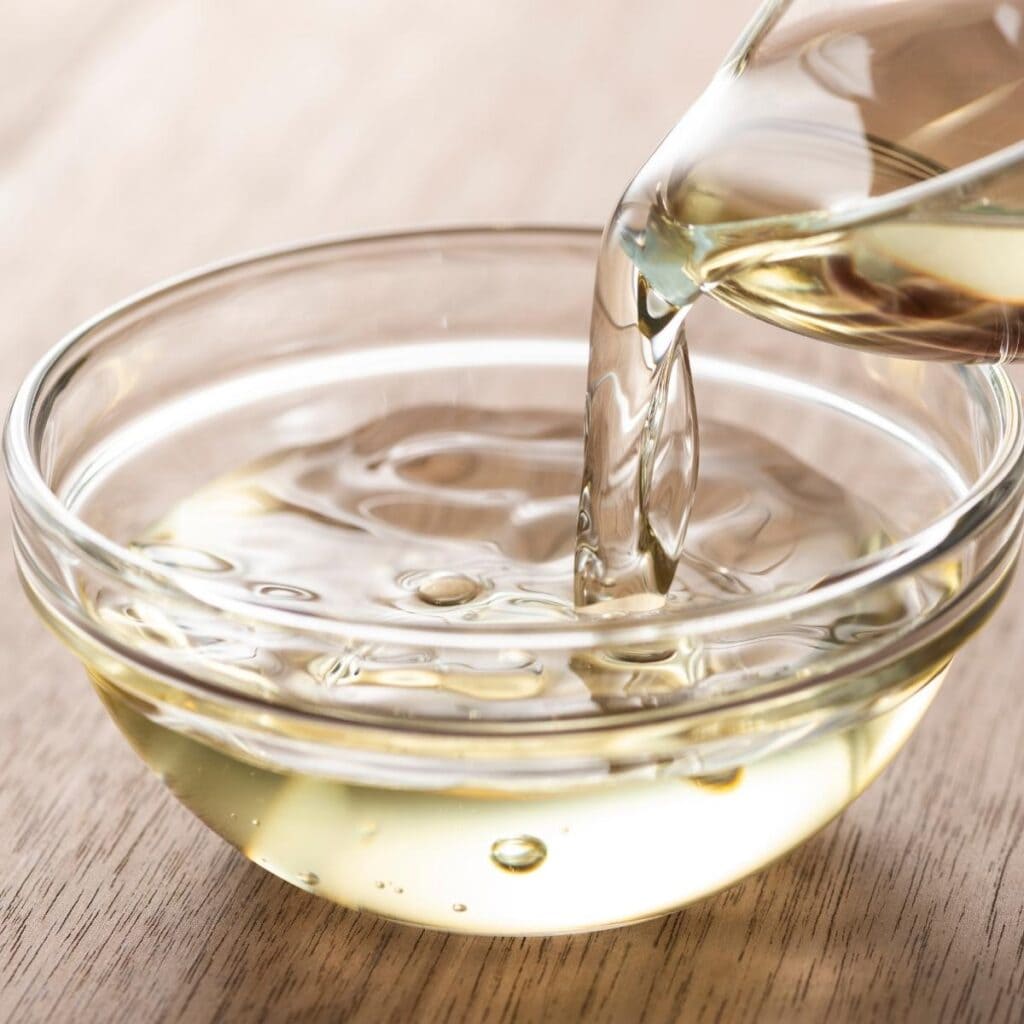If you love Japanese cuisine, you’ll know it’s vital to have some mirin substitutes on hand.
Because while the original is best, it’s not always easy to find. And without it, your Asian-inspired dinner will be missing that special something.

Japanese cooking is rich with deliciously complex flavor profiles. And much of that flavor comes from specialized ingredients, like mirin.
For example, it’s a prominent ingredient in Teriyaki sauce, which makes a super flavorful chicken dinner.
Therefore, making space for mirin in your pantry is important.
Or, make sure you have some handy mirin substitutes in your back pocket.
What Is Mirin?
Mirin is a type of rice wine used in Japanese cuisine. Similar to sake, it has a sweet flavor profile and contains less alcohol than regular wine.
It’s rich, tangy, salty, and quite sweet.
And while you can consume mirin as a beverage, it’s primarily used in cooking as:
- A soup base
- A braising liquid
- In sauces
Mirin provides a flavor that you’ve almost definitely tasted but probably couldn’t put your finger on. Unless, of course, you’re a pro at Japanese cooking.
It is great because it provides flavor and also enhances other seasonings. So, every bite is seriously tasty.
What are the Best Mirin Substitutes in Recipes?
The best mirin substitutes in recipes need to have a sweet and sour umami-rich flavor.
Some options are sweeter than others, and some are more savory.
However, sake is generally considered the best option for substituting mirin because it’s the closest in taste and consistency.
That said, there are other options, which we’ll explore below.
So, if you’re in the middle of cooking and find you’ve run out, these mirin substitutes should do the trick.
Meshiagare 召し上がれ! Bon appetite!

1. Sake + Sugar
Like mirin, sake is a fermented rice wine, which makes it a fantastic substitute.
Sake is more acidic, more alcoholic, and much less sweet than mirin.
Still, it’s a delicious and pretty close substitute – especially if you add some sugar to the mix.
That said, sake is a terrific option if you’re watching your sugar intake. It’s also great if you don’t love overly sweet, savory foods.
Sake works best in fish dishes or dishes where the recipe doesn’t call for much mirin.
How to Substitute: Swap 1 tablespoon of mirin with 1 tablespoon of sake + 1 teaspoon of sugar (or honey).
Note: Add sake a little earlier than you would add mirin so the alcohol has enough time to cook off before serving.

2. Dry Sherry
Sherry is an ideal mirin alternative because you can choose the type depending on your recipe.
That means using dry sherry for savory dishes and sweet sherry for something, well, sweet.
Of course, it works with whatever kind you have around, adding acidity to brighten up your dish.
Sherry works best for sauces, marinades, and braising.
How to Substitute: Swap 1 tablespoon of mirin with 1 tablespoon of dry sherry + 1/2 teaspoon of sugar.
Note: Dry sherry is not as sweet as mirin, which is why you’ll add sugar. But I suggest tasting the recipe and then adding more, as needed.

3. Dry White Wine
White wine is already used in cooking all around the world, so we know it’s good.
And it’s the one thing many of us have on hand at all times. Unless you’re an avid cook, you’re more likely to stock wine than sherry, right?
Dry white wine works best as a mirin substitute, especially in soups, sauces, and marinades. And just like sherry, you’ll need to add sugar to the mix.
Go for Sauvignon Blanc or Pinot Grigio. Just remember that you don’t want anything too expensive.
Since you’re cooking with it, you won’t get the whole flavor, which would be a waste of an expensive bottle.
How to Substitute: Swap 1 tablespoon of mirin with 1 tablespoon of white wine + 1/2 teaspoon of sugar.
If you’ve never tried cooking with white wine, give this easy chicken piccata recipe a try. I bet you’ll love it!

4. Shaoxing Cooking Wine (Chinese Cooking Wine)
Shaoxing is sort of like the Chinese version of sake.
It has a lovely nutty flavor, with a hint of vinegar, spice, and caramel. That’s what makes it a great substitute for mirin – lots of umami goodness.
Like sake, you’ll need to add Shaoxing a little sooner than mirin to cook off the alcohol, leaving behind flavor only.
Shaoxing works well for any dish where you’d need to use mirin, but I like it most in Japanese curries.
How to Substitute: Swap 1 tablespoon of mirin with 1 tablespoon of Shaoxing mixed + 1/2 teaspoon of sugar.

5. Aji-Mirin
Aji-Mirin is a type of rice cooking wine. And it’s probably the best swap on the list because it’s made to mimic the real thing.
But I didn’t place it at the top of the list for one reason: if you don’t have mirin on hand, you probably won’t have aji-mirin either.
The key differences between the two include:
- Mirin is made by fermenting rice over long periods of time.
- Aji-mirin features a mixture of water, corn syrup, alcohol, rice, and salt.
That blend of ingredients makes aji-mirin faster to produce, and, therefore, cheaper.
Still, it’s the closest swap you’ll find. However, I find it slightly salty, so you may need to cut the salt in the recipe a bit.
How to Substitute: Swap 1 tablespoon of mirin with 1 tablespoon of aji-mirin.

6. Vermouth
Vermouth is another fabulous substitute for mirin because of its slightly fruity flavor.
It’s sweet, but not nearly as sweet as mirin. So you may have to add some sugar, depending on how you like your food.
That said, sweet vermouth is pretty darn close and should give you the same sweet acidity. So maybe try it without the sugar and see how you like it.
Vermouth works very well as a mirin substitute in sauces and marinades.
How to Substitute: Swap 1 tablespoon of mirin with 1 tablespoon of vermouth + 1/2 teaspoon of sugar.

7. DIY Mirin – Sake + Sugar + Water
If you need mirin, why not just make it yourself? It won’t taste exactly the same, but it’s very close.
And it’s delicious regardless. Here’s how to make DIY mirin:
- Add 1/4 cup of sugar and 3 tablespoons of water to a pot.
- Bring the pot to a boil.
- Remove it from the heat and mix in 3/4 cup of sake.
- Stir until the sugar has fully dissolved.
- Let it cool and store it in an airtight container.
When it’s cool, you can use this exactly how you’d use mirin.
How to Substitute: Swap an equal amount of DIY mirin for mirin (1:1).

8. White Grape Juice
If you like things sweet try white grape juice as a mirin substitute!
This is actually one of the only swaps that doesn’t include extra sugar.
In fact, it’s so sweet, you’ll need to add some acidity to mellow it out. I like lemon juice since it’s got a kick of citrus too.
Grab the unsweetened kind, so it’s not cloyingly sweet. And be sure to get a decent brand without a bunch of additives.
This substitution works best for sweet marinades and sauces, like homemade teriyaki.
How to Substitute: Swap 1 tablespoon of mirin with 1 tablespoon of of white grape juice + 1/2 teaspoon of lemon juice.

9. Balsamic Vinegar
I know the color is totally opposite, but the rich, sour, umami taste of balsamic vinegar is a fantastic substitute for mirin.
Balsamic works well because of its acidity and sweetness.
That said, since the taste of balsamic vinegar is so strong, you don’t need much. I suggest adding a small amount and tasting as you go.
This substitute is best in sauces, braising liquids, and marinades.
How to Substitute: Swap 1 tablespoon of mirin with 2 teaspoons of vinegar.

10. Kombucha
If you’re a bit of a health nut, there’s a good chance you already love kombucha. Or maybe you’ve tried a kombucha cocktail and fell in love.
Well, now you have another reason to love it: it’s a fantastic mirin substitute!
Mirin is fermented and so is kombucha, so both liquids have a lovely, sour taste.
Of course, you don’t want to use a super fruity kombucha as it will affect the flavor of your dish.
Plain or ginger kombuchas will be your best choices. But I’m not going to stop you if you want to experiment.
Kombucha will work for all recipes that use mirin.
How to Substitute: Substitute an equal amount of kombucha for mirin (1:1).

11. Water + Honey
While I generally love all things honey, this substitution should be your last resort.
Sure, it adds plenty of flavor, but you won’t get the same richness as mirin.
Still, it works well in sweet dishes and sauces.
I suggest adding a splash of white wine, sake, lemon juice, or kombucha for some acidity.
That might mess with the consistency of your dish, though, so don’t go crazy.
How to Substitute: Swap 1 tablespoon of mirin with 1 tablespoon of water + 1 teaspoon of honey.











